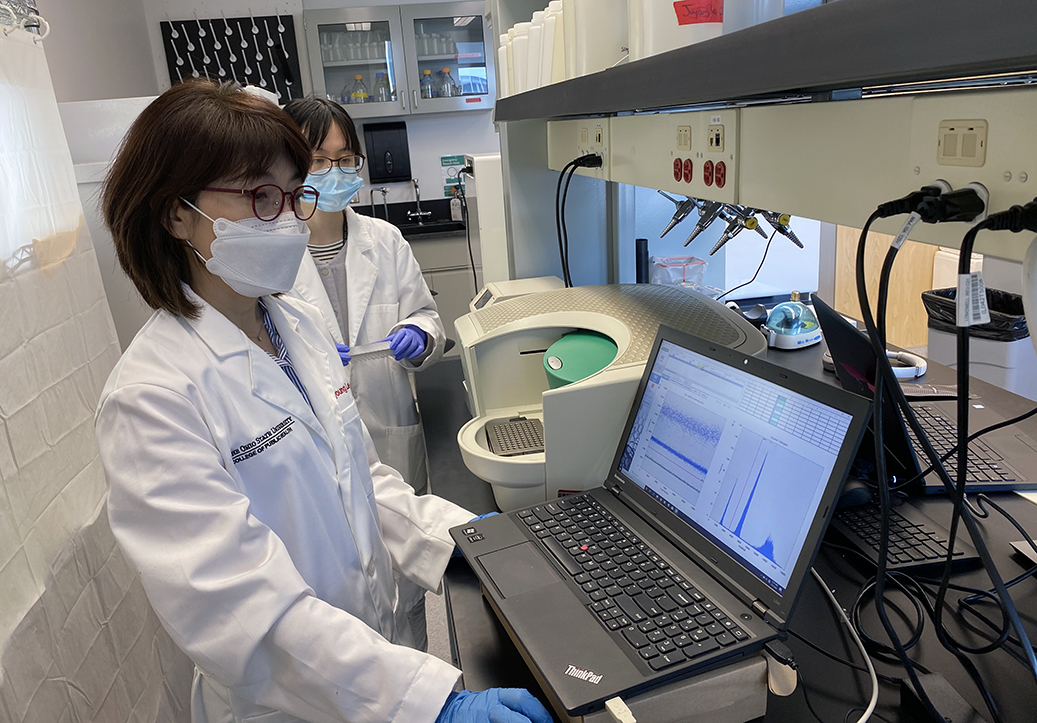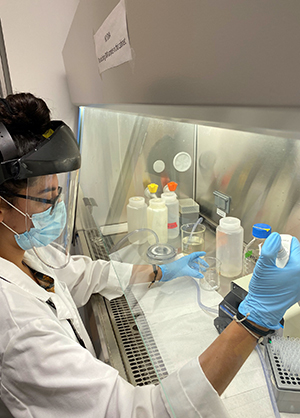Looking for a COVID-19 early warning
Public health professor’s lab monitoring campus, state wastewater
By Denise Blough

Hard at work on the fourth floor of Cunz Hall, a team of researchers is helping detect the prevalence of COVID-19 on campus and in communities across Ohio.
By testing wastewater on its way to treatment plants for coronavirus RNA, the team — led by Professor of Environmental Health Sciences Jiyoung Lee — is gathering valuable data that could predict where COVID-19 outbreaks may soon occur.
Because coronavirus fragments are shed through waste by people infected with COVID-19 — even when they don't have symptoms — wastewater monitoring is an especially telling tool for disease surveillance, Lee said. Recent science suggests that coronavirus RNA can be detected in wastewater up to seven days before increases in cases and hospitalizations.
“This kind of surveillance can give population-level assessments and be an early warning for disease spread,” said Lee, also a professor of food science and technology and a co-director of the Ecology, Epidemiology and Population Health program at Ohio State’s Infectious Diseases Institute.
Her lab is currently conducting these four COVID-19 wastewater projects in collaboration with partners across the university and state:
- As part of a statewide effort, the Cunz Hall team receives and tests wastewater samples from Columbus, Cleveland, Newark, Lancaster, Athens, Delaware, Marysville and Marietta. The research is supported by the Ohio Environmental Protection Agency, Ohio Department of Health and federal CARES (Coronavirus Aid, Relief, and Economic Security) Act.
- Wastewater from Ohio prisons is processed for a project funded by the Ohio Department of Rehabilitation and Correction.
- Most recently, the lab began monitoring wastewater from on-campus sites including dorms and a quarantine site
- The team is also testing stormwater from storm sewer systems in Columbus and other Ohio cities.
Looking to wastewater for early signals of disease spread isn’t unique to this pandemic. In the past, wastewater has been monitored for other public health threats like polio, antimicrobial resistance and opioids.
Lee’s lab developed unique methods to process and evaluate wastewater for SARS-CoV-2 (COVID-19) RNA. Every week, they share their data with the relevant state agencies. Campus data is sent to a computational modeling and analysis team led by Mark Weir, assistant professor of environmental health sciences, before being shared with Ohio State’s Comprehensive Monitoring Team.
“We are trying to assess what the level of infection seen in the concentrations actually means, and if rises in the sample numbers indicate something to be concerned about and respond to, Weir said.
The numbers are inherently complicated to interpret considering waste levels vary by person and by day, Weir said.
“You don’t have the same amount of COVID genetic material coming out of you every single day the entire time you’re infected — it’s variable,” he said. “We try to take into account as much of that as possible.”
Weir is also on the campus wastewater sampling team, which twice a week collects wastewater from multiple campus sewers. Collecting, transporting and handling the samples in Lee’s lab all require an extra level of personal protective gear per guidelines from the Centers for Disease Control and Prevention.
 Typically, Lee’s team currently spends full days completing filtrations of samples from locations across the state, said Angela Davis (right), a research associate in Lee's lab and recent graduate of the Environmental Sciences Graduate Program.
Typically, Lee’s team currently spends full days completing filtrations of samples from locations across the state, said Angela Davis (right), a research associate in Lee's lab and recent graduate of the Environmental Sciences Graduate Program.
“In between sample processing, we are constantly preparing for future samples, such as making more reagents, sterilizing equipment and ordering more materials,” she said. “Days can be long, but the research is very interesting and we enjoy it."
The lab receives wastewater from more than 30 sources and rapidly processes a large number of samples, Lee said.
“I expect the pandemic to continue to be a hot topic for research organizations across the world and having the opportunity to develop techniques for this type of research will be extremely valuable,” Davis said.
Other Ohio State individuals involved in this research include Yuehan Ai, Zuzana Bohrerova, Kent Halloran, Fan He, Natalie Hull, Madeline Lewis, Emily Lu, Judith Straathof and Ryan Winston.
About The Ohio State University College of Public Health
The Ohio State University College of Public Health is a leader in educating students, creating new knowledge through research, and improving the livelihoods and well-being of people in Ohio and beyond. The College's divisions include biostatistics, environmental health sciences, epidemiology, health behavior and health promotion, and health services management and policy. It is ranked 22nd among all colleges and programs of public health in the nation, and first in Ohio, by U.S. News and World Report. Its specialty programs are also considered among the best in the country. The MHA program is ranked 5th and the health policy and management specialty is ranked 21st.